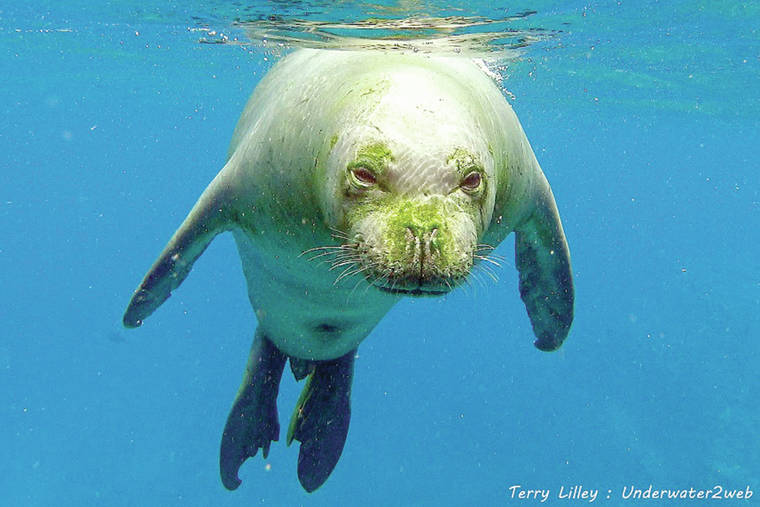The monk seal is endemic to the Hawaiian Islands and a very rare creature growing up to eight feet long and weighing 600 pounds. There is thought to be only about 1,000 of these amazing animals left alive on earth, and most of them live in the remote Northwestern Hawaiian Islands. Monk seals are regarded as living fossils because they have changed very little over the past 15 million years. The Hawaiian monk seals had close cousins that lived in the Caribbean Sea, but they have recently gone extinct.
Over the past 20 years about 80 monk seals have shown up in the main Hawaiian Islands, and we now often see them sleeping up on the beach during the day. Their curious nature brings them up close to us when we are scuba diving. In old Hawai‘i, monk seals were more common and were hunted for food, and they have also been drowned in fishing nets and killed by military activity. Large sharks like the tiger shark and Galapagos shark will eat the monk seal babies, and it is though that the monk seals are migrating back to the main Hawaiian Islands to get away from the large shark population in the Northwestern Hawaiian Islands. Since the monk seal is now fully protected under the U.S. Endangered Species Act they are safe from human harm on our crowded Hawaiian beaches.
Monk seals feed mostly at night by themselves in depths all the way down to over 1,000 feet, where they eat octopus, lobsters, crabs, fish and eels. They can hold their breath for a long period of time, and when not feeding they are often sleeping up on the beach, digesting their food in the warm sun. When diving with the monk seals underwater, they act like dogs, as they will come right up to you and look into your mask, bite at your air bubbles, do circles around you, wanting to play, and they even make a loud, barking noise underwater. Their Hawaiian name, “‘ilio holo i ka uaua,” means “quadruped running in the rough seas,” referring to a dog in the ocean.
Some of the best places to see the monk seals is on the beach when they are resting on Kaua‘i and O‘ahu, often nursing their newborn pup. It is mandatory by law that you stay at least 50 feet away from the sleeping monk seals, but when out scuba diving in places like Ni‘ihau, they will follow you around like they are your long-lost friend. As a general rule they do not bother people, but they are very territorial and will bark at, bite and chase off other monk seals. They will also take on and chase off a 300-pound, eight- foot long shark.
See the Hawaiian monk seal in action in the movie “Hawaiian Marine Mammals” at underwater2web.com and also follow my daily marine life post on my Instagram and Facebook under my name.
Aloha from under the waves.
•••
Terry Lilley, a marine biologist, lives in Hanalei. His websites include underwater-2web.com and gofundme.com/5urrm4zw.



